Jim Morris
Glass Ferrules
Since our last Cressy Cane, most of my making/building energy has been devoted to experimenting further with Glass ferrules. The 3-pce Perfectionist I produced for Cressy was the first prototype and since then I’ve finished four, 2-pce rods ranging from a 7’ PHY Driggs through to an extended PHY Para 15 of 8’6” (yep, it is very parabolic!). Although all of the ferrules look good and have performed well, the not unexpected conclusion with 2-pce rods is that lighter, more flexible ferrules are an interesting novelty, but probably don’t make a huge difference to how they cast because of their location and number.
Aside from the 3-pce Perfectionist, I’ve also built two other 3-pce rods with glass ferrules. The first is an 8’6” Leonard 51 (6 weight) which is an excellent lake rod. It would be pointless quoting the weight, because the blank was heavy to begin with (impregnated) and I also experimented using a solid (no filler) screwlock nickel silver reel seat (a bit like a heavy duty Granger seat) which added more weight. However, the weight is all in the ‘right place’ as they say, so it balances a fairly light reel. With the right line (I use a Scientific Anglers WF6 Heritage which is true to weight and has a nice long front taper for delicate presentations) the rod is excellent with both dries and wets and feels so ‘fluid’ you can happily cast it all day. The final 3-pce was a ‘parts bin special’ from Chapmans in the UK prior to them closing after John injured his back. The blank was an extended Leonard DF50 (9ft instead of the usual 8ft) and 4/5 weight. I built it as intended, but it was so parabolic, I cut it down to 8’6” and am much happier with it now as a light line (4wt) river rod, great for protecting the lightest tippets and like the bigger rod it flexes like a one piece. Conclusion? Lighter, flexible ferrules can be a big plus for 3-pce rods.
Finally, 4-pce ‘pack rods’. I made a great conventional 4-pce, 8 foot PHY ‘Martha Marie’ based rod under Nick’s wonderful tutelage a few years ago, so I’ve been really keen to see how these lighter, flexible ferrules work in this configuration. Remember, with a 4-pce rod you have one and a half ferrules north of the mid point, so that is quite a lot of extra weight through the tips! As I was starting the project consisting of 2 solid blanks, our beloved 13 year old Labrador Rosie passed away from cancer, so these two pack rods became the ‘Rosie Rods’ and their livery reflects her black coat. Both are based on the ever popular and great casting PHY Para 15 taper but stretched out to 8’6” because that’s the length I like most for lake fishing. My ‘recipe’ for the taper started as a conventional 8’0”, 2-pce, which then got modified on Hexrod – basically adding 6 inches to the length, but also designating the rod as a one piece, so it could be cut in half and then into quarters. Without going into too much detail, one blank retained the stress curve of the original 2-pce, while the other blank got slightly more pronounced transition points or steps in the stresses. Both blanks were built out with a screwlock NS reelseat, size 12 agate stripper, 9 snake guides and 3 coats of varnish. The first blank to be finished (the one with more pronounced stress points), was also fitted with ferrules made from slightly lighter glass than its sibling (from a 5wt as opposed to a 6wt). I chose heavier glass for the second build to see how much the strength of the ferrules contributes (if at all) to the overall feel of the rod. Total rod weights ended up a respectable 5 and 5.25 ounces which you might expect in an 8 foot six weight bamboo rod with those fittings, but not an 8’6”.
So, how do they go? The slightly lighter rod is definitely a little more parabolic. It loads easily at close distances and once you are used to its slower rhythm will push out a long line. However, for me It feels most comfortable at moderate distances (to say 20 metres) and really excels in the accuracy department at that range. A great rod for targeting tailing or midging fish when speed, accuracy and delicacy are required. The relatively long length and deep bend also makes fighting a big fish very comfortable! (see ‘The unluckiest fish’ below).
The virus lock down occurred just as I finished the second rod (Rosie V2), so I’ve yet to cast that one, let alone take it fishing. However, it definitely has more muscle in the bottom two sections, so I’m very keen to try it out. At the moment, it looks like those heavier glass ferrules (although still flexible) may well have contributed to its greater butt strength, so that’s a possible extra ‘tweak’ glass ferrules can apply to a taper.
Glass Ferrules
Since our last Cressy Cane, most of my making/building energy has been devoted to experimenting further with Glass ferrules. The 3-pce Perfectionist I produced for Cressy was the first prototype and since then I’ve finished four, 2-pce rods ranging from a 7’ PHY Driggs through to an extended PHY Para 15 of 8’6” (yep, it is very parabolic!). Although all of the ferrules look good and have performed well, the not unexpected conclusion with 2-pce rods is that lighter, more flexible ferrules are an interesting novelty, but probably don’t make a huge difference to how they cast because of their location and number.
Aside from the 3-pce Perfectionist, I’ve also built two other 3-pce rods with glass ferrules. The first is an 8’6” Leonard 51 (6 weight) which is an excellent lake rod. It would be pointless quoting the weight, because the blank was heavy to begin with (impregnated) and I also experimented using a solid (no filler) screwlock nickel silver reel seat (a bit like a heavy duty Granger seat) which added more weight. However, the weight is all in the ‘right place’ as they say, so it balances a fairly light reel. With the right line (I use a Scientific Anglers WF6 Heritage which is true to weight and has a nice long front taper for delicate presentations) the rod is excellent with both dries and wets and feels so ‘fluid’ you can happily cast it all day. The final 3-pce was a ‘parts bin special’ from Chapmans in the UK prior to them closing after John injured his back. The blank was an extended Leonard DF50 (9ft instead of the usual 8ft) and 4/5 weight. I built it as intended, but it was so parabolic, I cut it down to 8’6” and am much happier with it now as a light line (4wt) river rod, great for protecting the lightest tippets and like the bigger rod it flexes like a one piece. Conclusion? Lighter, flexible ferrules can be a big plus for 3-pce rods.
Finally, 4-pce ‘pack rods’. I made a great conventional 4-pce, 8 foot PHY ‘Martha Marie’ based rod under Nick’s wonderful tutelage a few years ago, so I’ve been really keen to see how these lighter, flexible ferrules work in this configuration. Remember, with a 4-pce rod you have one and a half ferrules north of the mid point, so that is quite a lot of extra weight through the tips! As I was starting the project consisting of 2 solid blanks, our beloved 13 year old Labrador Rosie passed away from cancer, so these two pack rods became the ‘Rosie Rods’ and their livery reflects her black coat. Both are based on the ever popular and great casting PHY Para 15 taper but stretched out to 8’6” because that’s the length I like most for lake fishing. My ‘recipe’ for the taper started as a conventional 8’0”, 2-pce, which then got modified on Hexrod – basically adding 6 inches to the length, but also designating the rod as a one piece, so it could be cut in half and then into quarters. Without going into too much detail, one blank retained the stress curve of the original 2-pce, while the other blank got slightly more pronounced transition points or steps in the stresses. Both blanks were built out with a screwlock NS reelseat, size 12 agate stripper, 9 snake guides and 3 coats of varnish. The first blank to be finished (the one with more pronounced stress points), was also fitted with ferrules made from slightly lighter glass than its sibling (from a 5wt as opposed to a 6wt). I chose heavier glass for the second build to see how much the strength of the ferrules contributes (if at all) to the overall feel of the rod. Total rod weights ended up a respectable 5 and 5.25 ounces which you might expect in an 8 foot six weight bamboo rod with those fittings, but not an 8’6”.
So, how do they go? The slightly lighter rod is definitely a little more parabolic. It loads easily at close distances and once you are used to its slower rhythm will push out a long line. However, for me It feels most comfortable at moderate distances (to say 20 metres) and really excels in the accuracy department at that range. A great rod for targeting tailing or midging fish when speed, accuracy and delicacy are required. The relatively long length and deep bend also makes fighting a big fish very comfortable! (see ‘The unluckiest fish’ below).
The virus lock down occurred just as I finished the second rod (Rosie V2), so I’ve yet to cast that one, let alone take it fishing. However, it definitely has more muscle in the bottom two sections, so I’m very keen to try it out. At the moment, it looks like those heavier glass ferrules (although still flexible) may well have contributed to its greater butt strength, so that’s a possible extra ‘tweak’ glass ferrules can apply to a taper.
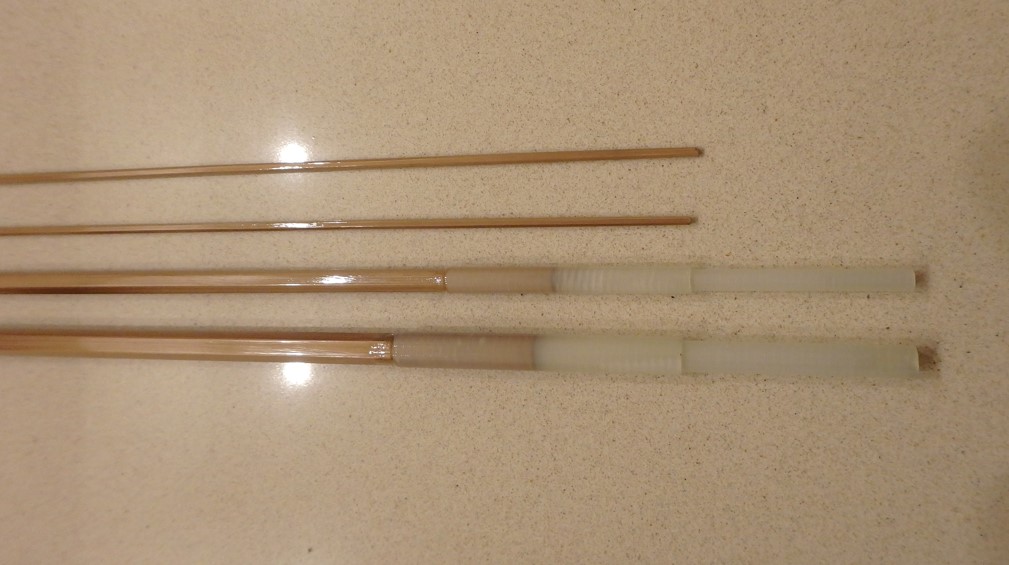
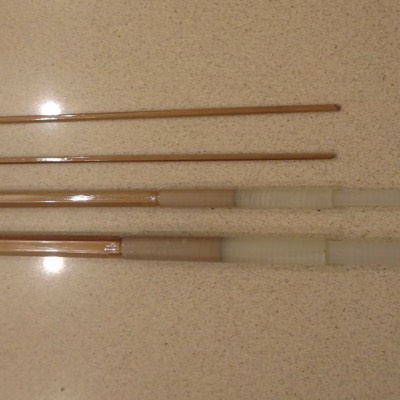
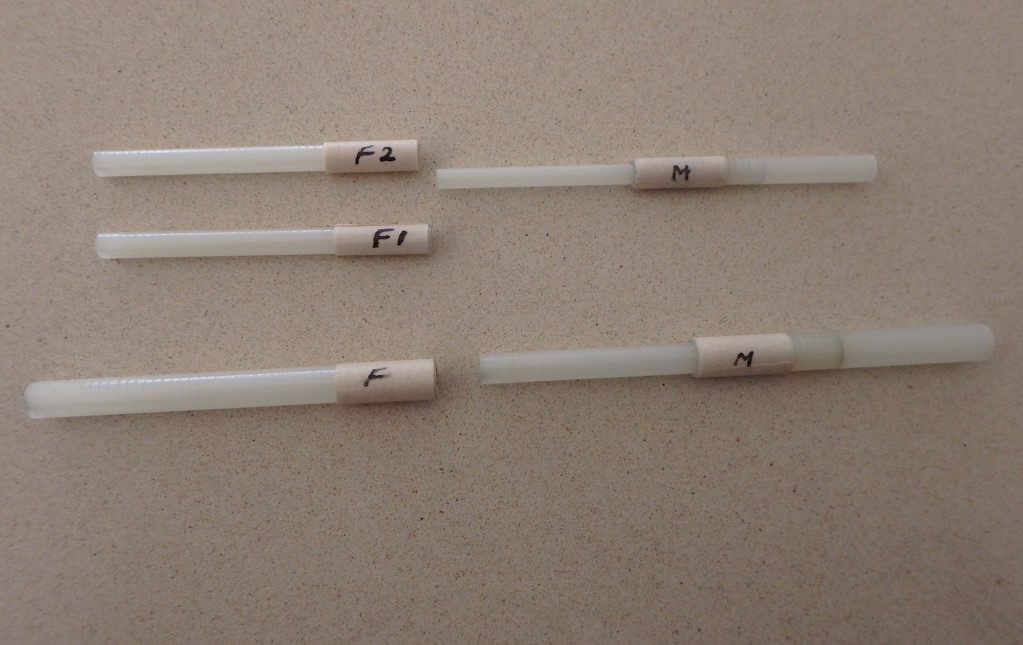
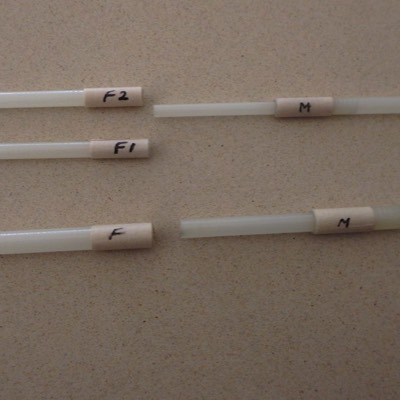
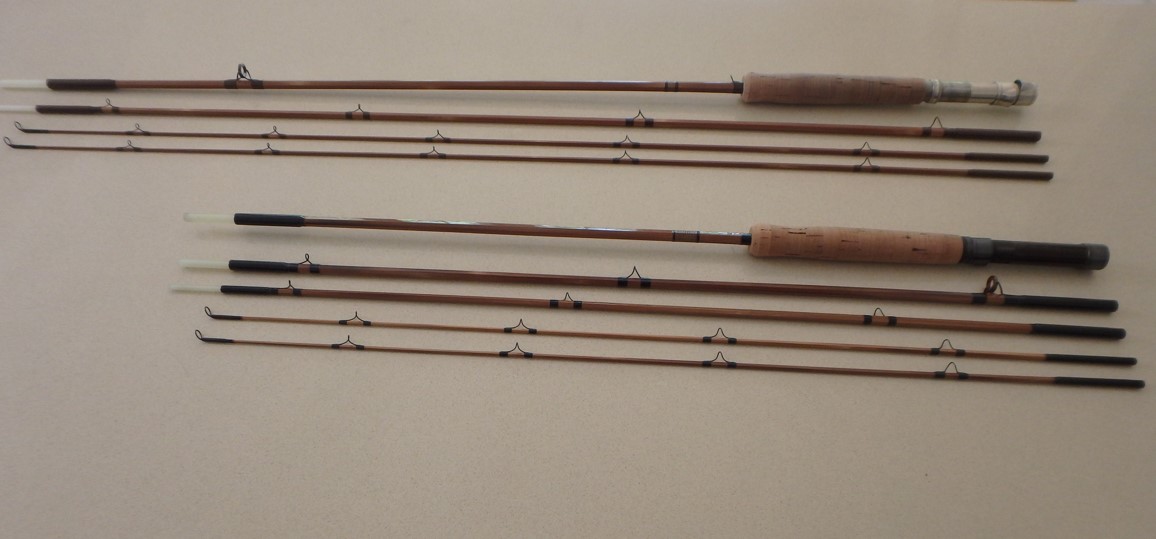
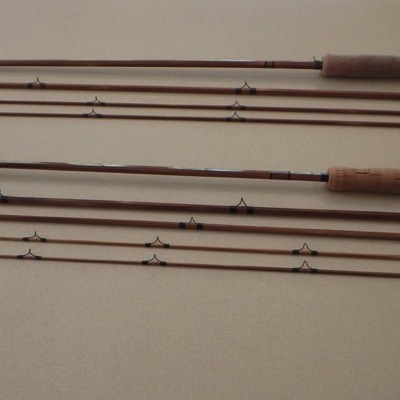
Tall, but true trout tales from the Summer of 2019/2020.
I’ve fly fished since a very young age, yet both of the stories below are novel experiences for me and both occurred just months apart:
1. Long line release?
Early summer with a Mayfly hatch in full swing, I carefully waded out to a familiar reef just off the shore of a lake I fish often in Tasmania’s highlands. For some unknown reason and expecting more wind, I had left an unusual set of three dry flies on my 15 foot tapered leader, whereas I would normally prefer to use just one fly, sometimes two. In my defence, I speculated that if the wind was already up I could try a spot of semi-dapping since that had worked the day before and to do that I only had to snip off my top dropper. My top dropper was a claret sedge and on the end of my tippet was a large, bushy size 10 dapping fly of my own design. Attached to the bend of the dapping fly was my third offering just a foot or so behind it – a dark brown possum emerger. On previous afternoons when the wind got up, I had found that the dapping fly attracted curious fish as it skidded across the surface above a drop off, but they preferred to take the emerger skimming along just behind it.
Anyhow, out I carefully waded after spotting a rise and decided to leave on the 3 flies to save time, even though the breeze had just calmed making the dapping fly totally expedient. Within 5 minutes I located a decent sized brownie working a slow beat between two sets of rocks and a semi-submerged log. I patiently waited for the fish to return and when it rose to take a newly hatched mayfly just beyond the nearest set of rocks, carefully cast my three flies three or so metres ahead and across its intended path. I waited until I was sure the fish must have reached my flies, but nothing! I kept waiting, barely daring to draw breath, when finally a large green head emerged and engulfed the middle fly, the dapping fly. Despite my shock at its choice, I managed to pause before lifting into the weight of an obviously good fish. What followed was a textbook struggle with a sizeable brown trout – relatively short, powerful runs, head down and shaking, while looking for the safety of deeper water. Several times I steered it away from known obstructions, aware of the danger of the trailing fly and finally felt confident enough to unclip my net as the fish began to flag and come closer to the surface. A short lunge and then he weakened enough for me to put on the pressure and guide him head first towards the net. Alas, just as the net slipped under his deep, thick body, he made one last desperate beat of that fabulously broad tail and I had to dip the net out of the way for fear of hooking my emerger in the mesh as he slipped off. Damn! He was still on but determined to do another lunge for freedom; I’d have to bide my time, slacken off the pressure and then bring him around again. Suddenly that lunge took on a new dimension and he took off on a screaming run almost into the backing! Wow, what a fish and where did he get that renewed energy from? This time he weakened far more quickly, did a short, fast second run and then gave up the fight completely. I pulled him in close and just as I got the net into position to lift up below him, I noticed a stripe of pink down his side! I raised the net and was astonished to discover an older triploid rainbow (female) of approximately the same size and weight as the brownie I had tried to land only a minute before, but this fish was firmly hooked in the corner of its mouth by the Possum emerger. For a moment I thought: “this must be what dementia feels like”, then realized that my first fish had been ‘released’ by the rainbow as it grabbed the trailing fly and took off!
2. The unluckiest fish?
I release 99% of the trout I catch. I love the catching part and all the planning, experimentation and problem solving that goes with it, but rarely like eating them and much prefer to eat saltwater species. When I’m occasionally cajoled into killing a trout by a family member, I tend to do the job on a smaller young fish from a lake with plentiful stocks.
On this particular occasion, I was planning to fish an early morning midge hatch on a Tasmanian highland lake. I really enjoy the challenge of midge fishing and although I know from experience that you are far more likely to be successful catching midging fish using a wet fly (especially a small wet fly) pulled away from the fish as it swims towards you, that method just doesn’t float my boat any more, because you don’t see the take. An additional problem of catching rainbows in particular by the wet fly method is that the bigger fish will often inhale a small wet fly right down into their stomachs before you even know they are on and that means catch and release is a real problem. Instead, I find it far more exciting and rewarding to catch midging fish on a dry fly and to that end have spent years experimenting with small dries that do the job even in a big hatch when your offering is competing with thousands of the real thing. Of course dries don’t always work, but let’s face it, at my age quality always trumps quantity! Besides, fishing a small dry (or two) to a rapidly and sometimes erratically feeding rainbow is also a great way to practice accurate, subtle presentations.
Anyhow, there I was with a good hatch of midges on the water, the fish just keying onto them in the surface film in the rapidly expanding dawn light and then the wind suddenly started to blow in from the west as I launched my dinghy. Aargh! I knew instantly I’d only get in 15 minutes maximum before the fish went down, so time was of the essence! Added to that pressure was the fact that I was now desperate to catch at least one fish on my recently completed 4-pce, glass ferruled ‘Rosie Rod’ before returning home that afternoon and was still smarting at an ‘operator error’ I had stupidly made the evening before which had lost a good fish late in the fight on the same rod.
As the wind freshened, I noticed that it was creating a short lived ‘wind lane’ out of the surface food on the far side of the bay and it was possible that there would still be a couple of fish feeding in it if only I could get there on my electric before it all blew away! five agonizing minutes later I arrived at the remnants of the wind lane and the and breeze fortuitously eased for a few minutes. Almost immediately I spotted what looked to be a good rainbow working the edge of the slick water and manuevered the dinghy to place me within casting range to the side and downwind of the rising fish. I cast quickly three to four metres ahead of the next rise and stood there struggling to stop the boat as it began to drift while simultaneously squinting to see my flies against the glare of the water as the sun cleared the horizon. The fish sipped just to the right of where I thought my flies were and then rose again moments later closer to the mark. I was unsighted, but thought the second rise must be one of my flies, so I paused very briefly before lifting. In fact the leader began to move before I could even strike, so I backed off a little and instead tightened into the increasing weight on the end of my vanishing line! It was a good fish – several long searing runs and one spectacular cartwheeling leap before slugging it out under and around the dinghy for what felt like several minutes. After one false lunge with the net, I managed to drag her towards the boat with head up for just a couple of metres. This time the net was under the fish and then up clear of the water. ‘Rosie’ had handled the fight magnificently with a deep, powerful bend into much of its 8’6” length as the fish surged across the lake. A fitting tribute to our gentle, but unusually quirky Labrador. Wow, such a beautiful, thick, deep fish in great condition just had to go back with minimal handling and was just a perfect first fish for that rod! I admired her for just a few seconds and then lowered the net back into the water beside the boat to remove that small fly I could see in the corner of her mouth. Forceps out I pinned down the handle of the net to keep things still and eased the dropper fly free with the fish still in the water. Now, where had that point fly got to? Was it caught in the net, or was it wrapped around her somewhere, so I couldn’t slip her straight back into the water? Oh shit, there was my tippet vanishing deep into her mouth, meaning she might even be hooked in the gills! But no, hooked in the gills would have been a blessing – the point fly had been inhaled right down into the fish’s stomach and its fate was sealed even before it gulped down my second fly. I keep a priest in my kit for these rare occasions and unfortunately it had to be used. A post mortem confirmed that the second fly was embedded deep into the stomach wall and combined with the length of tippet inside the stomach would probably have led to a slow death. If only I had struck after that first rise!
With the deed done, the breeze increased steadily and I didn’t see another rise, so I headed back for breakfast.
Ironically, this large rainbow in beautiful condition made a terrible meal – it was obviously older than its plump, unmarked condition indicated and even cooked fresh to a time-tested recipe, its flesh was dry with an unusual taint to it. Sadly the worst tasting and unluckiest trout we’ve ever eaten!
I’ve fly fished since a very young age, yet both of the stories below are novel experiences for me and both occurred just months apart:
1. Long line release?
Early summer with a Mayfly hatch in full swing, I carefully waded out to a familiar reef just off the shore of a lake I fish often in Tasmania’s highlands. For some unknown reason and expecting more wind, I had left an unusual set of three dry flies on my 15 foot tapered leader, whereas I would normally prefer to use just one fly, sometimes two. In my defence, I speculated that if the wind was already up I could try a spot of semi-dapping since that had worked the day before and to do that I only had to snip off my top dropper. My top dropper was a claret sedge and on the end of my tippet was a large, bushy size 10 dapping fly of my own design. Attached to the bend of the dapping fly was my third offering just a foot or so behind it – a dark brown possum emerger. On previous afternoons when the wind got up, I had found that the dapping fly attracted curious fish as it skidded across the surface above a drop off, but they preferred to take the emerger skimming along just behind it.
Anyhow, out I carefully waded after spotting a rise and decided to leave on the 3 flies to save time, even though the breeze had just calmed making the dapping fly totally expedient. Within 5 minutes I located a decent sized brownie working a slow beat between two sets of rocks and a semi-submerged log. I patiently waited for the fish to return and when it rose to take a newly hatched mayfly just beyond the nearest set of rocks, carefully cast my three flies three or so metres ahead and across its intended path. I waited until I was sure the fish must have reached my flies, but nothing! I kept waiting, barely daring to draw breath, when finally a large green head emerged and engulfed the middle fly, the dapping fly. Despite my shock at its choice, I managed to pause before lifting into the weight of an obviously good fish. What followed was a textbook struggle with a sizeable brown trout – relatively short, powerful runs, head down and shaking, while looking for the safety of deeper water. Several times I steered it away from known obstructions, aware of the danger of the trailing fly and finally felt confident enough to unclip my net as the fish began to flag and come closer to the surface. A short lunge and then he weakened enough for me to put on the pressure and guide him head first towards the net. Alas, just as the net slipped under his deep, thick body, he made one last desperate beat of that fabulously broad tail and I had to dip the net out of the way for fear of hooking my emerger in the mesh as he slipped off. Damn! He was still on but determined to do another lunge for freedom; I’d have to bide my time, slacken off the pressure and then bring him around again. Suddenly that lunge took on a new dimension and he took off on a screaming run almost into the backing! Wow, what a fish and where did he get that renewed energy from? This time he weakened far more quickly, did a short, fast second run and then gave up the fight completely. I pulled him in close and just as I got the net into position to lift up below him, I noticed a stripe of pink down his side! I raised the net and was astonished to discover an older triploid rainbow (female) of approximately the same size and weight as the brownie I had tried to land only a minute before, but this fish was firmly hooked in the corner of its mouth by the Possum emerger. For a moment I thought: “this must be what dementia feels like”, then realized that my first fish had been ‘released’ by the rainbow as it grabbed the trailing fly and took off!
2. The unluckiest fish?
I release 99% of the trout I catch. I love the catching part and all the planning, experimentation and problem solving that goes with it, but rarely like eating them and much prefer to eat saltwater species. When I’m occasionally cajoled into killing a trout by a family member, I tend to do the job on a smaller young fish from a lake with plentiful stocks.
On this particular occasion, I was planning to fish an early morning midge hatch on a Tasmanian highland lake. I really enjoy the challenge of midge fishing and although I know from experience that you are far more likely to be successful catching midging fish using a wet fly (especially a small wet fly) pulled away from the fish as it swims towards you, that method just doesn’t float my boat any more, because you don’t see the take. An additional problem of catching rainbows in particular by the wet fly method is that the bigger fish will often inhale a small wet fly right down into their stomachs before you even know they are on and that means catch and release is a real problem. Instead, I find it far more exciting and rewarding to catch midging fish on a dry fly and to that end have spent years experimenting with small dries that do the job even in a big hatch when your offering is competing with thousands of the real thing. Of course dries don’t always work, but let’s face it, at my age quality always trumps quantity! Besides, fishing a small dry (or two) to a rapidly and sometimes erratically feeding rainbow is also a great way to practice accurate, subtle presentations.
Anyhow, there I was with a good hatch of midges on the water, the fish just keying onto them in the surface film in the rapidly expanding dawn light and then the wind suddenly started to blow in from the west as I launched my dinghy. Aargh! I knew instantly I’d only get in 15 minutes maximum before the fish went down, so time was of the essence! Added to that pressure was the fact that I was now desperate to catch at least one fish on my recently completed 4-pce, glass ferruled ‘Rosie Rod’ before returning home that afternoon and was still smarting at an ‘operator error’ I had stupidly made the evening before which had lost a good fish late in the fight on the same rod.
As the wind freshened, I noticed that it was creating a short lived ‘wind lane’ out of the surface food on the far side of the bay and it was possible that there would still be a couple of fish feeding in it if only I could get there on my electric before it all blew away! five agonizing minutes later I arrived at the remnants of the wind lane and the and breeze fortuitously eased for a few minutes. Almost immediately I spotted what looked to be a good rainbow working the edge of the slick water and manuevered the dinghy to place me within casting range to the side and downwind of the rising fish. I cast quickly three to four metres ahead of the next rise and stood there struggling to stop the boat as it began to drift while simultaneously squinting to see my flies against the glare of the water as the sun cleared the horizon. The fish sipped just to the right of where I thought my flies were and then rose again moments later closer to the mark. I was unsighted, but thought the second rise must be one of my flies, so I paused very briefly before lifting. In fact the leader began to move before I could even strike, so I backed off a little and instead tightened into the increasing weight on the end of my vanishing line! It was a good fish – several long searing runs and one spectacular cartwheeling leap before slugging it out under and around the dinghy for what felt like several minutes. After one false lunge with the net, I managed to drag her towards the boat with head up for just a couple of metres. This time the net was under the fish and then up clear of the water. ‘Rosie’ had handled the fight magnificently with a deep, powerful bend into much of its 8’6” length as the fish surged across the lake. A fitting tribute to our gentle, but unusually quirky Labrador. Wow, such a beautiful, thick, deep fish in great condition just had to go back with minimal handling and was just a perfect first fish for that rod! I admired her for just a few seconds and then lowered the net back into the water beside the boat to remove that small fly I could see in the corner of her mouth. Forceps out I pinned down the handle of the net to keep things still and eased the dropper fly free with the fish still in the water. Now, where had that point fly got to? Was it caught in the net, or was it wrapped around her somewhere, so I couldn’t slip her straight back into the water? Oh shit, there was my tippet vanishing deep into her mouth, meaning she might even be hooked in the gills! But no, hooked in the gills would have been a blessing – the point fly had been inhaled right down into the fish’s stomach and its fate was sealed even before it gulped down my second fly. I keep a priest in my kit for these rare occasions and unfortunately it had to be used. A post mortem confirmed that the second fly was embedded deep into the stomach wall and combined with the length of tippet inside the stomach would probably have led to a slow death. If only I had struck after that first rise!
With the deed done, the breeze increased steadily and I didn’t see another rise, so I headed back for breakfast.
Ironically, this large rainbow in beautiful condition made a terrible meal – it was obviously older than its plump, unmarked condition indicated and even cooked fresh to a time-tested recipe, its flesh was dry with an unusual taint to it. Sadly the worst tasting and unluckiest trout we’ve ever eaten!